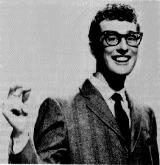

Charles Hardin Holley
was born in Lubbock, Texas on September 7, 1936--Labor Day, appropriately--and
quite promptly dubbed
"Buddy" by his ma (for rock-and-roll's sake, it's lucky that little Charles
escaped that other standard Texas nickname: Bubba). Buddy's parents and
two older brothers and sister were musical, and as a boy he joined the
family jams on violin or piano. The first indication of his unusual talent
came at age five, when his brothers, hoping to score points for cuteness,
dragged him along on stage at a talent show. Much to his brothers' annoyance,
Buddy won first prize.
By junior high Buddy
had turned his attention to the guitar, and formed a western duo with his
friend Bob Montgomery. The two became very popular in Lubbock and eventually
rated their own half-hour radio show on KDAV-AM. During the mid-fifties,
the boys opened for the likes of Elvis, Marty Robbins, and Bill Haley at
local shows. Eddie Crandall, the booking agent who arranged for their appearance
with Bill Haley, liked Buddy enough to send some of his demos to Decca
Records. From this, in early 1956, came Buddy's first record contract offer.
He signed it, even though to his chagrin the contract left out his friend
Bob and misspelled his name as Holly (at least they didn't change his name
to something stupid like Engelbert Humperdinck).
Buddy recorded a number
of songs for Decca during 1956, of which "Blue Days, Black Nights"/"Love
Me" and "Modern Don Juan"/"You Are My One Desire" were released. However,
neither record met with commercial success, and his contract was not renewed
(fools). The next set of demo records Buddy made were with Norman Petty,
of NorVaJak Studios in Clovis, New Mexico. Petty (who would become as integral
to Buddy's success as any musician) was a brilliant producer and engineer
with previous "rock" hits to his credit. And, unlike the fools at Decca,
he allowed Buddy to play guitar as well as sing. It was with him that Buddy
and his band--now known as the Crickets and comprising Jerry Allison on
drums, Niki Sullivan on guitar, and Joe Mauldin on bass--cut "That'll Be
The Day". Bought by Brunswick and released in June of 1957, this tune hit
number one on the American charts and sold over one million records. The
Crickets had arrived.
Through 1957 and 1958,
Buddy continued to release many hit records under Petty's tutelage, as
a member of the Crickets on Brunswick and as a solo artist on Coral. The
group toured extensively in both the States and in Australia and England.
In December 1957, American television audiences got their first look at
their new four-eyed idol when the Crickets sang "That'll Be The Day" and
their two new hits, "Oh Boy!" and "Peggy Sue," on the Ed Sullivan Show.
Ed also interviewed Buddy on the air, giving Americans their first taste
of his amazing West Texas accent as well.
Buddy stopped by his publishers'
office in New York one day in July of 1958 to discuss some business. At
the receptionists'
desk was pretty Maria
Elena Santiago, and according to legend it took Buddy less than thirty
seconds to ask her for a date. Within days, Buddy (who had, ironically,
recorded "Take Your Time" not six months ago) had asked her to marry him.
After their wedding in August, the relationship between Norman Petty, Buddy,
and the other Crickets began to disintegrate. Newly married Buddy became
displeased with his friends' rowdiness, and Petty made no secret of his
displeasure at the marriage (even suggesting that Maria Elena masquerade
as the Crickets' secretary to avoid alienating female fans). In October,
Buddy split with his band and producer and moved to New York to pursue
a solo career. He and Maria Elena lived in Greenwich Village (can't ya
just see him hanging out with Jack Kerouac, playing the bongos?)
In January 1959, Buddy
embarked on the now-infamous "Winter Dance Party" along with Dion and the
Belmonts, Ritchie
Valens, and fellow Texan
J. P. Richardson (otherwise known as the "Big Bopper"). The accomodations
for this trek through the frozen tundra of the upper midwest were apparently
not ideal, as Buddy's drummer, Carl Bunch, came down with frostbite while
inside the band bus. After their February 2 appearance at the Surf Ballroom
in Clear Lake, Iowa, Buddy chartered a small plane for himself and his
remaining backup musicians--Waylon Jennings and Tommy Allsup--as transportation
to the tour's next gig in Moorhead, Minnesota. The Bopper, who had a cold,
wheedled Allsup's seat away from him and Jennings' seat was lost to Valens
in a last-minute coin toss. The plane took off shortly after 1 A.M. on
the morning of February 3 in a snowstorm and crashed almost immediately,
killing the three musicians and the plane's young pilot, Roger Peterson.
Buddy Holly is unique
in the history of rock and roll for many reasons. The Crickets are considered
the first "self-contained" rock and roll band (i.e., what you hear on the
record is what you get live). His use of echo, double-tracking, and string
sections in the studio were unprecedented. He single-handedly popularized
the Fender Stratocaster electric guitar. And, gosh darn it, he wore big-ass
glasses and hiccupped while he sang.
That said, I feel compelled
to correct one common myth in regards to the Great Myopic One: he was not
a nerd. Despite his image as some prehistoric Dilbert--which was branded
into the public psyche with Gary Busey's Buddy Holly Story
character--ole Buddy
was no pencil-necked geek. He drove a motorcycle. He wore pegged pants.
And, unlike most of the
heartthrob singers popular
in the fifties, Buddy didn't need to make himself up as a matinee idol:
He was cool enough the way he
was.
Buddy
Holly Lyrics
Midi Collection
Buddy
Impersonators
"Rave
On" in Real Audio